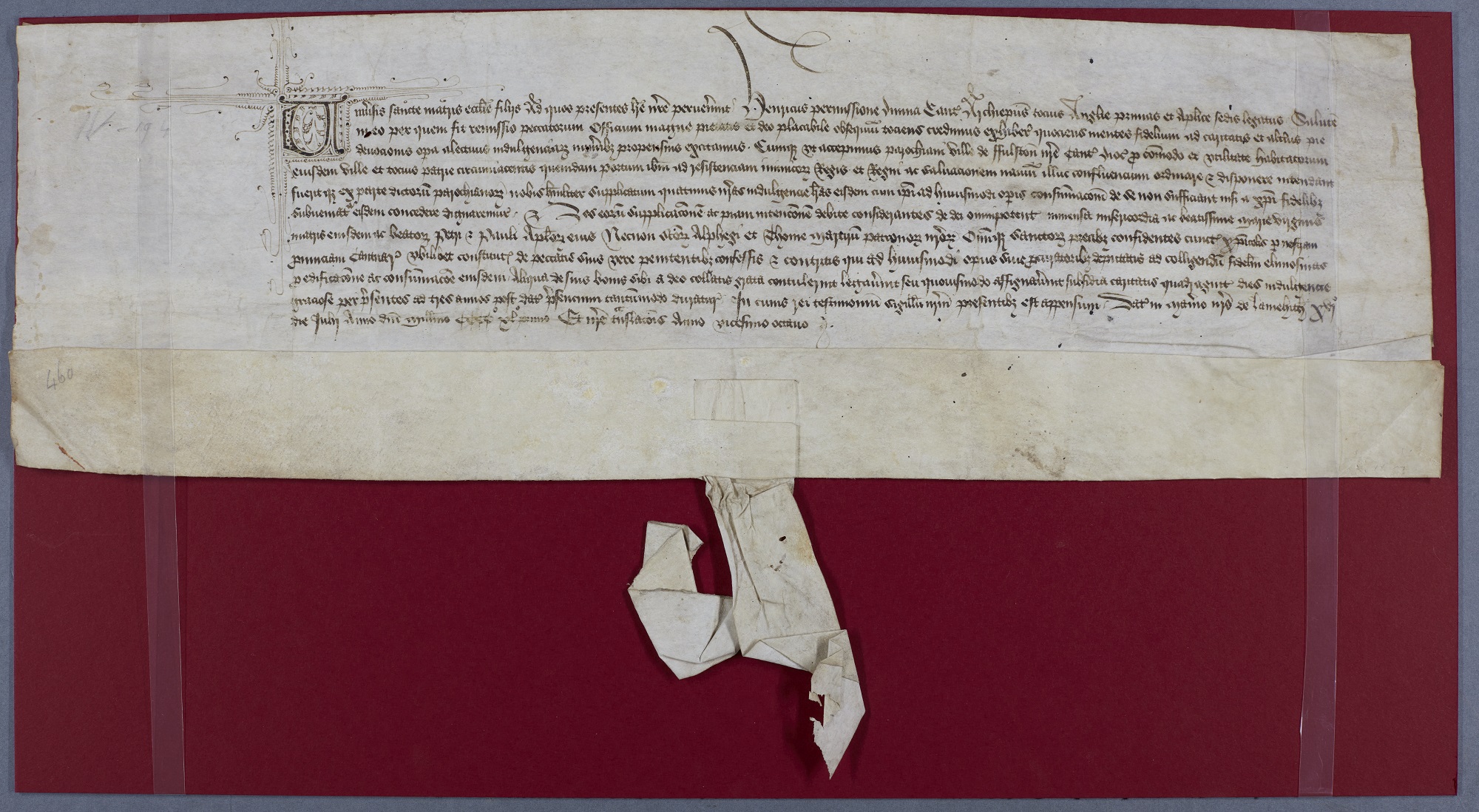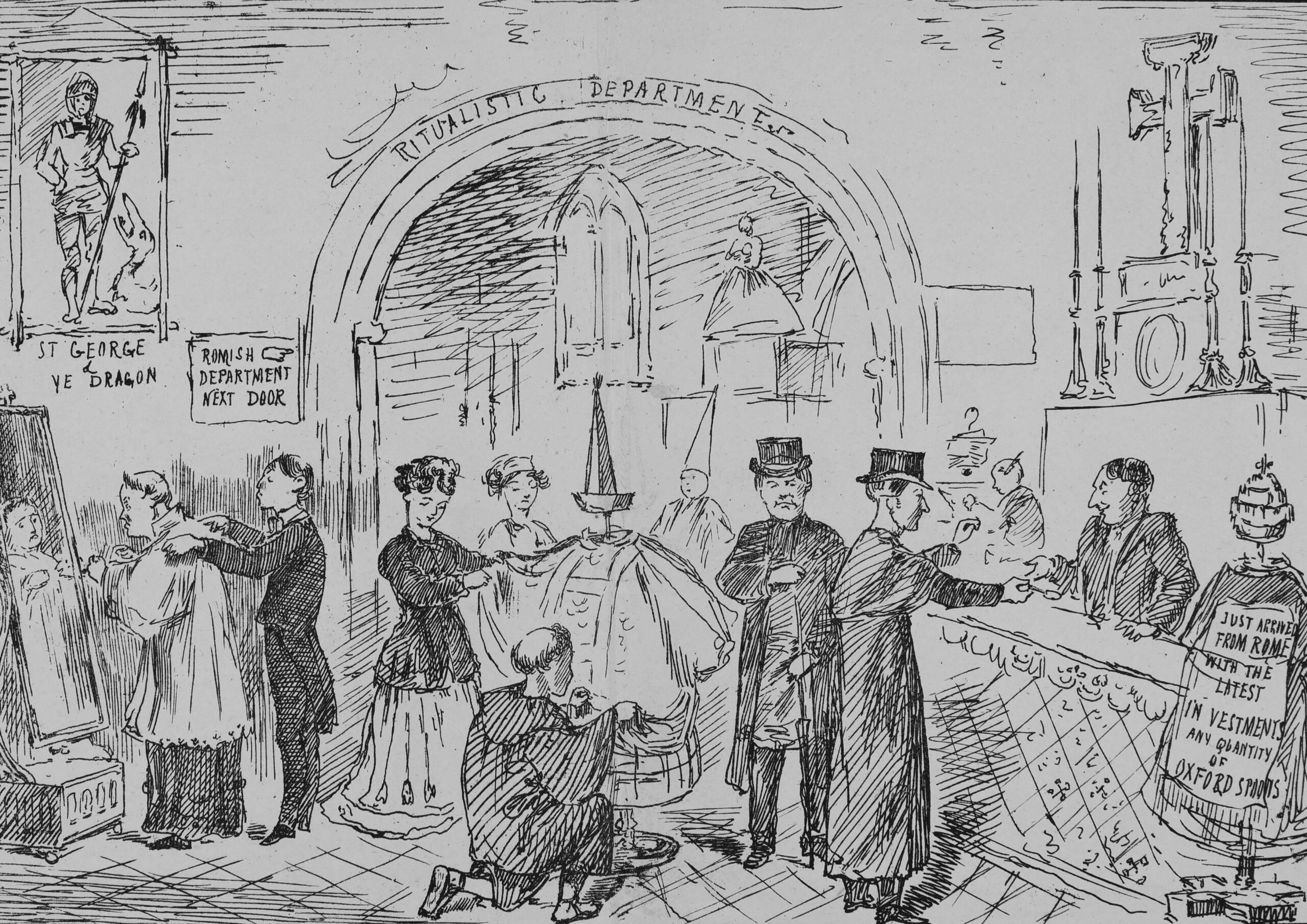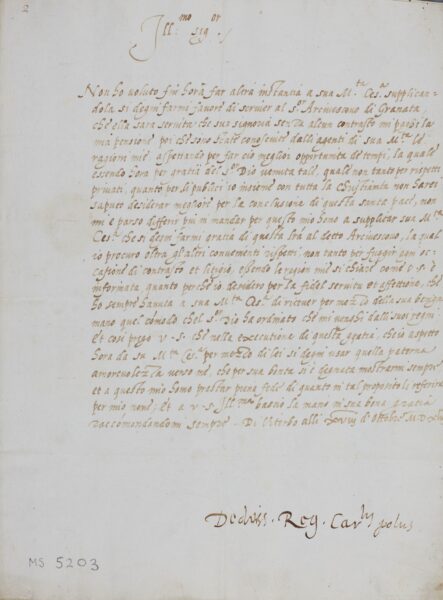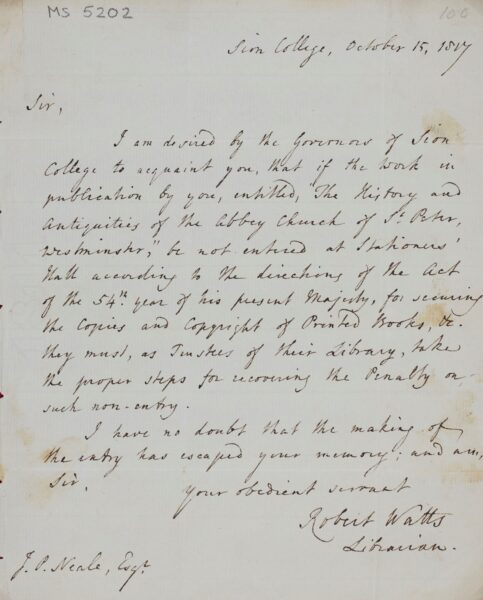This exhibition highlighted the Library’s acquisitions during a challenging few years. Recent arrivals built on the Library’s strengths in the fields of devotional literature, topographical writings and the evolution of religious libraries. Highlights included a copy of Quintilian’s Institutiones oratoriae that was once owned by Cardinal Morton, a medieval French book of Hours and a nineteenth century journal of Henry Evington, Bishop of Kyushu, Japan. In particular, the period of the Reformation is well represented with new items shedding light on the logistics of international diplomacy, the modus operandi of Matthew Hutton, Archbishop of York and the anti-Catholic propaganda that the religious upheaval produced. The acquisitions range from the fifteenth to the twentieth centuries, many purchased with the assistance of the Friends of Lambeth Palace Library.
The exhibition ran from 11 October to 22 December 2022.

King David spying on Bathsheba bathing, Honresfield Book of Hours
This liturgical book contains prayers to the Virgin Mary to be recited at certain times of day, hence the name ‘Book of Hours’. Thousands survive from the Middle Ages and, like this example, they are often lavishly decorated with scenes framed by elaborate floral borders.
The opening shows the beginning of the Penitential Psalms, biblical verses that were recited by the reader to express sorrow for their sins and ask for forgiveness. As they were believed to be written by King David, many are illustrated by him repenting or sinning. Here he spies on and lusts after a married woman, Bathsheba.
MS 5204, ff. 93v–94r
France [Paris], c. 1470s
Donated from the Blavatnik Honresfield Library by the Friends of the National Libraries, 2022
Thys prymer in Englyshe and in Laten is newly translatyd after the Laten texte (Paris [i.e. Rouen], 1538)
This primer was printed for the French publisher François Regnault (d. 1540/1), the primary producer of liturgical works for the English market in the 1520s and 1530s. An Act passed in 1536 restricted the activities of foreigners in the English book trade and French dominance of this market ended shortly afterwards. From the early 16th century more prayers and devotions in English found their way into primers, but the Latin text remained primary. In this edition, printed after Henry VIII’s break with Rome, the English text is more prominent, and the Latin text is relegated to a secondary role.
H5142.H6 1538 [**]
Donated from the Blavatnik Honresfield Library by the Friends of the National Libraries, 2022

Indulgence granted by Archbishop Henry Chichele

Indulgences were granted by the Church in order to reduce the amount of time the recipient spent in Purgatory or the severity of their punishment there, most often in exchange for performing good work on earth. This indulgence bestows 40 days of penance on the parish of the estate of Fulston, probably referring to a large medieval manor house in Sittingbourne, Kent, which is now destroyed. The first line tells us that it was granted by Henry Chichele (c. 1364–1443), Archbishop of Canterbury and founder of All Souls College in Oxford. His name, henricus, is emphasised with a penwork flourish.
CM 56
Lambeth, 16 July 1441
Purchased with support from the Friends of Lambeth Palace Library, 2021

Quintilian. Institutiones oratoriae (Venice,1471)
This copy of Quintilian’s Institutes of Oratory was owned by Cardinal John Morton, Archbishop of Canterbury between 1486 and 1500. Few books or manuscripts from Morton’s extensive library are known to survive and this one was the last recorded in private hands. The leaf shown here has his painted arms, and below this a rebus punning on Morton’s name – a barrel, or tun, bearing the letters MOR. After Morton, this book passed through the hands of several other owners, including William Hone (d. 1522), a Canon of Chichester, Master of Chichester prebendal school, and Latin tutor to the future Henry VIII.
SA6649.A2 1471 [**]
Purchased by the Friends of Lambeth Palace Library with support from the Friends of the National Libraries and the Trustees’ Mandell Creighton Fund, 2018
The book of common prayer, and administration of the sacraments, and other rites and ceremonies of the Church, according to the use of the Church of England (London, 1753)
This Book of Common Prayer has a contemporary eighteenth-century red velvet binding with gilt gauffered and painted edges, but it also incorporates the remnants of an earlier seventeenth-century embroidered binding. On each board there is a stumpwork centrepiece with a sunburst design surrounding a figure of the Virgin and child. A leather bookplate on the front pastedown of the volume shows that a Lucretia Compton owned the book in 1770. If it was she who transformed the binding, we can only speculate as to her motives. Was she inspired by Marian devotion? Was it to preserve the binding of a much-loved family book, or was it simply an aesthetic decision?
H5145.A4 1753
Purchased with support from the Friends of Lambeth Palace Library, 2019

Incensed protestants versus incensed ritualists (London, 1868)

This satirical pamphlet was published at a time when Anglo-Catholic liturgical practices and clerical dress were thought to be undermining the Protestant nature of the Church of England. This anxiety over ritualistic practices led to the Public Worship Regulation Act (1874), which resulted in the prosecution of a number of clergy for the use of candles, incense and unauthorised vestments in services.
H5123.I6 [P]
Purchased with support from the Friends of Lambeth Palace Library, 2020
Letters from Reginald Pole to Cardinal Farnese and Antoine Perrenot de Granvelle
Reginald Pole (1500–1558) spent two decades of his career in effective exile, having incurred the displeasure of Henry VIII for his views on the King’s marriage and the supremacy of the Pope. He was appointed papal legate on several occasions and was in frequent fear of assassination by Henry’s agents. Negotiating with the Holy Roman Emperor, Pope and King of France, Pole was at the centre of European diplomacy as the reformation unfolded. In these letters, which complement existing Pole correspondence at the Library, Pole is concerned about the consequences of slow communication and seeks a pension due to him from the Archdiocese of Granada.


Purchased with support from the Friends of Lambeth Palace Library, 2022
Letter from Queen Charlotte to the Archbishop
of Canterbury, Charles Manners-Sutton
Charlotte describes her husband George III’s reaction to the news that his regal powers have been removed from him in favour of his son, the future King George IV, and she thanks the Archbishop for breaking this unwelcome news to the King.

The letter complements related holdings such as MS 2107-2139, papers of Archbishop Manners-Sutton in his capacity as a member of the Queen’s Council during the final years of George III’s ‘madness’.
MS 5164, f. 1r
Windsor, 1811
Purchased with support from the Friends of Lambeth Palace Library, 2019

Henry VIII. Regis Angliae Henrici huius nominis octaui Assertio septem sacramentorum aduersus Martinum Lutherum (Lyon, 1561)
Originally published in 1521, Henry VIII’s defence of the seven sacraments against Martin Luther led to Pope Leo X awarding him the title ‘Defender of the Faith’, a title which British monarchs use to this day. This edition from 1561 has had some distinguished former owners, including the important French novelist Honoré d’Urfé (1567-1625) and the Washington National Cathedral.
G800.H3
Purchased with support from the Friends of Lambeth Palace Library, 2018
Memoires of the Hutton Family by A. C. Ducarel
Andrew Coltée Ducarel (1713–1785) held the post of Librarian at Lambeth for almost 30 years. He put a huge effort into ordering the Library’s collections, often with considerable assistance which he didn’t always acknowledge, and wrote histories of the archepiscopal palaces of Croydon and Lambeth.
Ducarel compiled a volume of biographies of two Matthew Huttons: one Archbishop of York (1529?–1606), and the other of Canterbury (1693–1758), for the latter’s brother, John Hutton. Shown here is the dedication page from the biographies displaying a watercolour of the coat of arms of the Hutton family of Marske (on the left), and copies of letters to the Archbishop of York, possibly compiled in preparation for the biography.


Purchased with support from the Friends of Lambeth Palace Library, and Robin Myers FSA, 2021

Letter from William Cecil, Baron Burghley, to Matthew Hutton, Dean of York
Matthew Hutton (1529?–1606) was made Dean of York in 1567 and was continuously active in securing the protestant reformation in the North. His preferred method for conversion was a gentle, persuasive approach, which Burghley endorsed and mentions in his postscript:
‘in sekying to reform those that ar out of the waye, the ordinary way to reduce them which I heare you [Hutton] use is, by gentle instruction of them first to se and fele their palpable errors, and so to prepare them to se the truth’.
The letter adds to the Library’s existing Hutton correspondence on ecclesiastical affairs.
L-2022-39
Buxton, 1577
Purchased with support from the Friends of Lambeth Palace Library, 2022
Letter from the Revd Robert Watts, Librarian of Sion College, to John Preston Neale

From 1710 until 1837, Sion College held a legal deposit privilege, whereby the College was entitled to a copy of any book registered at Stationers’ Hall. From 1814, it became the responsibility of the libraries to claim a copy, rather than of the author or publisher to deposit it. In this letter, the Revd Robert Watts requests a copy of The history and antiquities of the abbey church of St. Peter, Westminster, with text by E. W. Brayley and illustrations engraved by John Preston Neale, which Neale eventually published by subscription in 1818. Lambeth Palace Library has a copy of Neale’s work, but there is no copy in the Sion College collection, which was transferred to Lambeth in 1996.
MS 5202
London, 1817
Purchased with support from the Friends of Lambeth Palace Library, 2021
Diary of Bishop Henry Evington, Bishop of Kyushu and member of the Church Missionary Society

The diary covers the first of seven visits by Evington to Japan. The journey took eight and a half weeks. He travelled from London to Dieppe, Paris and then Marseilles where he boarded the mail steamer MM Sindh. The sea journey took him to Naples and Port Said, then passing through the recently opened Suez Canal to Aden and on to Galle in Ceylon, Singapore, Saigon and Hong Kong. Here he changed ship to the MM Menzaleh for Yokohama, Japan. After visiting Tokyo, he took the SS Oregonian for Kobe, and finally a train to Osaka. Evington illustrated his diary with photographs, sketches and news cuttings.
MS 5158
Entries from London to Osaka, 1874
Donated to Lambeth Palace Library in 2019
Vanheems and Wheeler catalogue, with annotations by Ronald Knox
Ronald Knox (1888–1957) came from a strongly evangelical and clerical family background. He earned numerous scholarships and prizes while at Oxford University, where he also developed his interest in Anglo-Catholicism. Knox was ordained priest in the Anglican Church in 1912 but had converted to Catholicism within five years. As well as holding a chaplaincy at Oxford, he wrote works on Christianity, some of them satirical in nature. Knox’s annotations in this catalogue of clerical outfits display this sense of humour, a trait which ran in the family (his brother ‘Evoe’ was editor of Punch).

Bearing the marks of Knox’s heavy use, the catalogue will receive conservation treatment after this exhibition.
London, c.1918
Purchased with support from the Friends of Lambeth Palace Library, 2021
The Holy Bible : containing the Old and New Testaments translated out of the original tongues and with the former translations diligently compared and revised, by His Majesty’s special command (Edinburgh, 1919)

Measuring less than 5cm in height and published under special licence, this miniature Bible on a model wooden lectern was designed to show how Bibles and other books in churches and libraries used to be chained to prevent unauthorised removal. So that readers could see the text and enjoy the plates that illustrate this tiny Bible, the publishers helpfully supplied a miniature magnifying glass.
E185 1919 [**]
Purchased with support from the Friends of Lambeth Palace Library, 2020
Religious Tract Society. Memorable Spots in English History and Heroes and Martyrs of the British Reformation (London, 1870?)
Founded in 1799, the Religious Tract Society was an evangelical, interdenominational Protestant organisation, the aim of which was to produce and distribute religious tracts to explain the tenets of Christianity to the British working class and to convert them. The scope of the Society’s publishing activities expanded rapidly from the 1820s and soon the Society was publishing tracts in over a hundred languages for use in the missions, as well as publishing religious books and periodicals aimed at both children and adults of all social classes. This publication consists of two sets of twelve cards, with colour images on one side and text on the other, issued together in a double-sided printed cardboard case, and is typical of the Society’s brand of improving literature.


H5067.M8 1870
Purchased with support from the Friends of Lambeth Palace Library, 2022

